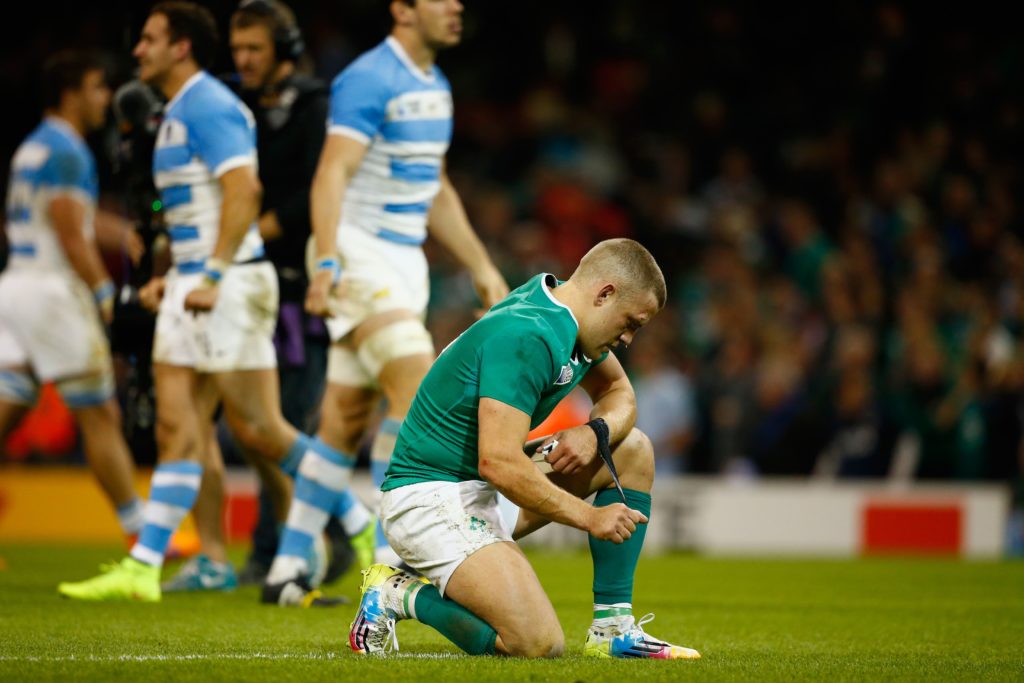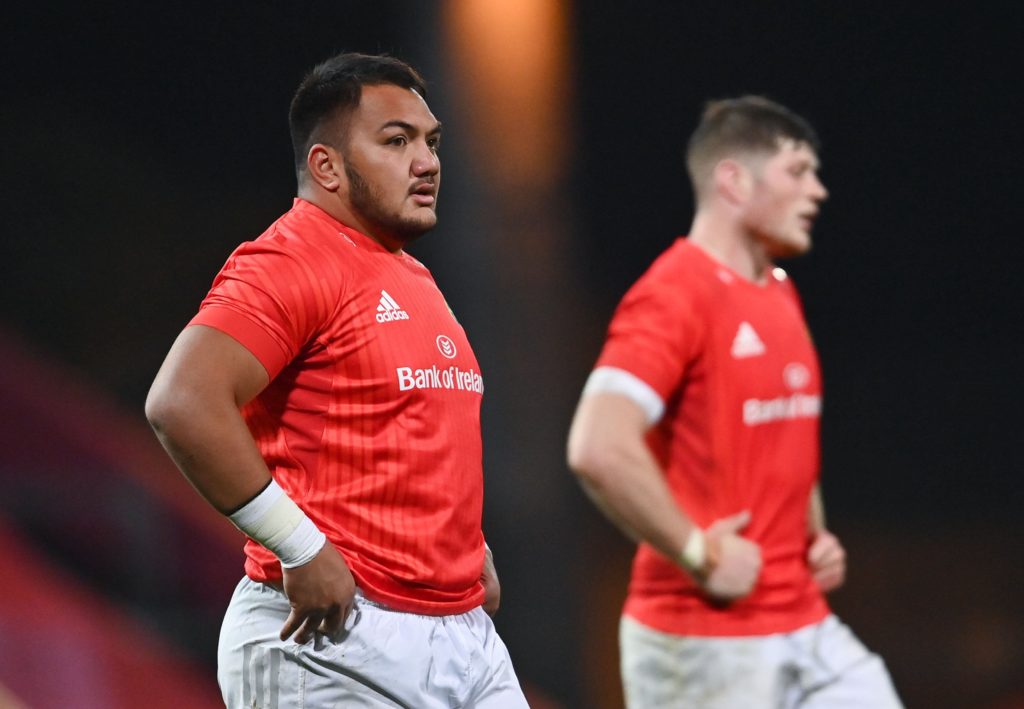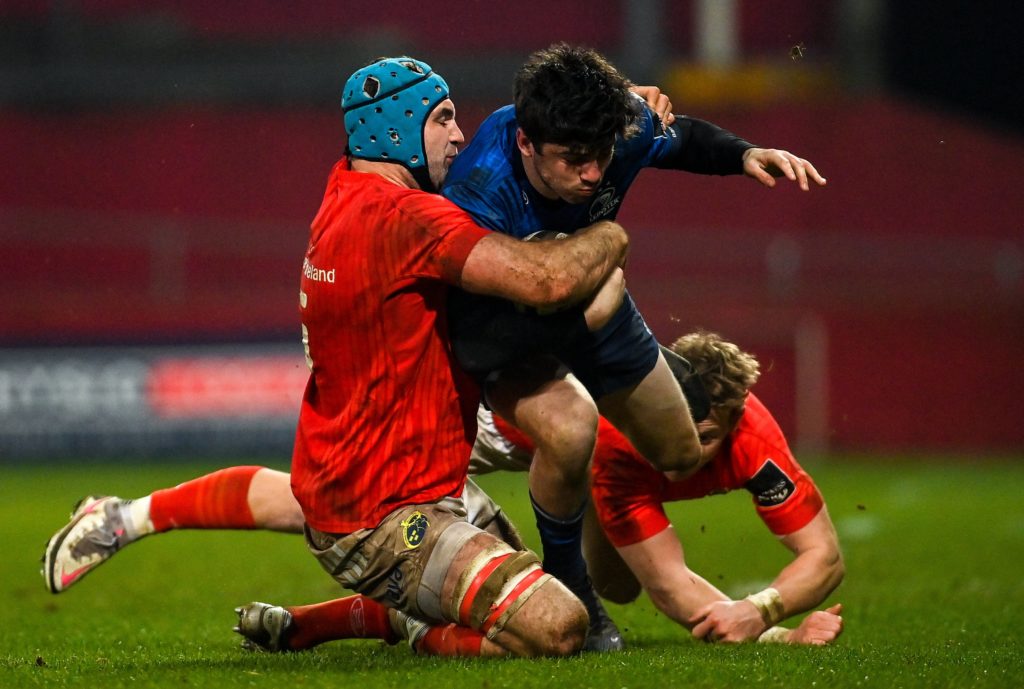In a bygone era, the first whispers of Irish rugby’s most contentious transfer could never have spread so far, and so wide, so quickly.
After all, the majority of the population walking through life with a personal camera at their fingertips is a relatively new development. More to the point, until recently, those sitting adjacent to a conversation between the national side’s head coach, and a key member of his squad, had no ready-made platform to spread an image of the meeting as far as interest could carry it.
Smartphones and social media have been society-altering advances, but the third factor that rendered Joey Carbery’s supposedly surreptitious catch-up with Joe Schmidt in a Dublin coffee shop during the spring of 2018 such a modern phenomenon, was not technological but sporting. It’s not so long ago that the idea of a representative of the IRFU making the case that a player would be better served leaving his native province for another would have felt an unlikely proposition.
While personal circumstances led to the likes of Dubliners Tony Ward and Shay Deering pulling on the red of Munster in the 1970s, the flow of traffic between Ireland’s four provinces had traditionally been closer to gridlock than today’s expanse of open road.
As the first decade of this century drew to a close, players such as Eoin Reddan and Mike Ross, and even the switch of Kiwi Isaac Boss from Ulster to Leinster, still felt like outliers. But by the time Carbery mulled over his flat white and his future the landscape had altered.

What happened was this.
In Leinster, the schools and academy system turned into a talent factory.
Urbanisation, population density, a vibrant schools scene with subsequently robust funding and standards driven by the level of competition to even get into the academy, were among the factors that produced such a stark overabundance of talent. With only so many players able to be accommodated on the roster of the four-time European champions, the surplus have found themselves spread across the island rather than lost to other countries or lost to the sport altogether.
Given the unwritten rule that those plying their trade abroad will not represent the Irish national team, the union’s preference for such a model is obvious in principle but it was only through the harsh lessons of the 2015 World Cup that a fast-tracking of the normalisation of scenes such as Carbery, Schmidt and the photo shared again and again, came to be treated like an imperative.
A point of discussion even before the appointment of David Nucifora as high performance director in 2014, it was as if the memory of that tournament’s quarter-final defeat – when an Irish team deprived of Paul O’Connell, Sean O’Brien, Peter O’Mahony, Jared Payne and, most importantly Johnny Sexton, were thumped by Argentina – provided hitherto absent clarity. Never again, the key decision makers thought, could they allow the side to be so hamstrung by the absence of key men…or one key man in particular.
With only so many players able to be accommodated on the roster of the four-time European champions, the surplus have found themselves spread across the island rather than lost to other countries or lost to the sport altogether.
So central was Sexton to Irish hopes, that in the wake of his injury in the final pool game against France, they were left a markedly different and markedly lesser team for the quarter-final showdown with the Pumas.
Ian Madigan had taken over the ten shirt for that chastening afternoon in Cardiff and, while blame for yet another knock-out failure could hardly be placed at his door, the fact that Sexton’s international back-up filled the same role at provincial level was hampering in the extreme.
With Madigan’s chances to get reps in the ten jersey limited to Sexton’s absences for both club and country, to then be asked to pull the strings in the most important contest of a four-year cycle was nothing more than a failure of planning, tantamount to throwing the understudy into opening night on Broadway having only allowed him a cursory glance at the script.
As Ireland set about a plan to finally have them in position to get over their quarter-final hoodoo by the time the next World Cup in Japan rolled around, Madigan’s move to Bordeaux the next summer took him out of the reckoning while Paddy Jackson’s involvement in a high-profile court case meant he too was out of the selection picture.

Accordingly, the emergence of Carbery, the youngster who saw out the historic maiden victory over the All Blacks in Chicago of 2016, became key.
Yet by the time Japan loomed nearer on the horizon and Schmidt and Carbery sat down together, the Blackrock College alum was enduring the same frustrations as Madigan had before him at Leinster, knowing that when it came to the crunch he’d be going into the biggest games with either a 15 or 22 on his back.
With memories of that Argentina debacle still fresh, and Jackson’s abrupt departure leaving a sizable void at Ravenhill, from the IRFU’s perspective, a move to Ulster would kill two birds with one stone. With the northern province pressing to sign Springbok Elton Jantjies, should no Irish alternative be sourced, time was of the essence. Alas, there was one stumbling block. Carbery didn’t want to go.
According to Schmidt’s 2019 autobiography, it was the attention afforded these aborted talks of a move that alerted officials in Munster to Carbery’s potential availability and, for the player it turned out, Limerick was a more appealing option than Belfast. On the eve of the national side’s tour to Australia later that year, his switch across Irish Rugby’s once-great divide was confirmed.
Whether Carbery’s subsequently subdued media performance that day was that of a young man drained from making a life-altering decision, or one just strong-armed into leaving his hometown against his wishes, depended on your interpretation and how closely you’ve watched the Zapruder film.
Whether Carbery’s subsequently subdued media performance that day was that of a young man drained from making a life-altering decision, or one just strong-armed into leaving his hometown against his wishes, depended on your interpretation and how closely you’ve watched the Zapruder film.
While conspiracy theories that Sexton’s heir apparent had been forcibly encouraged out of the RDS abounded, clear either way was Leinster’s angst over losing some of the much-valued depth so key to that year’s league and European double.
That the initial conversations with Carbery had taken place in the week of a Champions Cup quarter-final had stoked their anger further. Subsequently, when discussing the move, Cullen made pointed reference to the past “investment gone into him.”
Carbery’s continued injury woes have ensured Ireland are just as relient on a nearing 36-year-old Sexton as ever, but the fallout remains significant far beyond the on-field result.
Far from the first move of its kind, it was this reaction that seemed to represent some kind of line in the sand moment and when players of a lesser profile like Nick McCarthy and Roman Salanoa have made the same journey, the Leinster coach has made no great effort to hide his displeasure.

Like it or not, it will be no surprise if more transfers like these are confirmed in the coming months.
No sooner was the ink dry on Marcell Coetzee’s contract with the Bulls for next season than talk turned to how Ulster would absorb the blow of losing their best player. When it comes to replacing the near-irreplaceable, recent history is instructive. The most likely solution, no doubt much to the chagrin of those wearing blue-tinted glasses, lies 90 miles down the motorway at a club who had the luxury of facing Munster recently with international back-rowers Jack Conan and Josh van der Flier on the bench and grand slam winner, Dan Leavy, as well as, Scott Penny, outside the match-day 23.
Quite apart from the obvious impediment to his side’s strength in depth across a season, and all the more so during international windows when they bid adieu to a healthy chunk of their squad for weeks at a time, Cullen believes that this redistribution of wealth has put another roadblock in the way of his quest for a fourth consecutive league title.
After his side’s lengthy unbeaten Pro14 run came to an end at the hands of Connacht in their first game of 2021, Cullen cited the added motivation enjoyed by eight of the opposition’s starting 15, who were either former Leinster players or born within the province’s boundaries.
Quite apart from the obvious impediment to his side’s strength in depth across a season, Cullen believes that this redistribution of wealth has put another roadblock in the way of his quest for a fourth consecutive league title.
While it’s easy to imagine the level of sympathy coming from their more dowdy neighbours for such a plight, it’s easier still to have it outlined by Dan McFarland.
“Do I feel sorry for Leo? Are you joking? Do I feel sorry for him? That’s hilarious,” said the English-born Ulster head coach who spent the majority of his playing, and early coaching career, with Connacht.
With Ulster having fielded no less than 12 Leinster-born players so far this season – ranging from established stars such as Jack McGrath and Jordi Murphy, right down to those who latched on having not cracked the Leinster Academy out of school, like Alan O’Connor and Eric O’Sullivan – it’s a subject regularly pitched to McFarland during his media briefings.
His answers often offer a reminder that such borders are nothing more than happy accidents.
Evolving right up until the 17th century when the present boundaries were set by James I – until Tudor times the Louth area, home of Rob and Dave Kearney, was considered a part of Ulster – provincial distinctions once carried a degree of political consequence but are now essentially only prevalent in a sporting context where, aside from rugby, they are also used in indigenous sports such as Gaelic football and hurling.

“I always find it amazing the importance people put on which hospital you were born in,” McFarland said in the aftermath of his side’s loss to Leinster in the Pro14 final back in September. “I was born in a hospital in Chipping Norton, Oxfordshire, I have no interest in Chipping Norton.
“Apparently David Cameron lives there, that’s about as much as I know.
“I’ve got an English accent, does that mean I feel head-to-toe English? Part of me is English but I was 15 years in Ireland, [my son] Thomas was born here, my daughter Alex spent all her life here. Galway is a huge home for me.
“That’s a long way around of getting to the fact that (Dublin-born) Nick Timoney is an Ulsterman. When he pulls on that jersey he’s an Ulsterman, it’s just as simple as that.
“Men don’t fight for the flag, they don’t fight for motherhood, they don’t fight for apple pie. When they are faced with dangerous physical violence, men fight for their friends.”
Men don’t fight for the flag, they don’t fight for motherhood, they don’t fight for apple pie. When they are faced with dangerous physical violence, men fight for their friends.
Dan McFarland
Amidst the somewhat existential hand-wringing over what such volume of inter-provincial movement will do to dilute the passion of derby fixtures, the anticipation surrounding last week’s Munster versus Leinster clash in Thomond Park was a reminder that this rivalry still excites like no other. So much so that Springbok World Cup winner, Damian de Allende, admitted that the fervour surrounding it had been “a real shock” to him.
While Leinster won the game, thanks to a late Jordan Larmour try, that the South African was perhaps Munster’s best player on the day, and another contender was the Kildare-born Tadhg Beirne, who made his first steps in the professional game wearing Leinster blue, makes light of the fact that such spectacles are tied to nothing more than geography.
But the 25-year journey from representative provinces to professional clubs has been one of toing and froing, a tug of war between rugby’s lengthy amateur past and its hopes for a more financially lucrative future.
While the early days of Irish pros contracted to English sides being released back to their native sides for European fixtures has long felt like a quaint anachronism, just how much road is still to be traveled remains a point of ongoing debate.

Last week former Irish international lock Neil Francis wrote a column for the Irish Independent underneath the headline ‘When the dislike is real you have to cultivate it, but farming out Leinster players will kill interpro rivalries’ that mused upon proposals which would see a national academy established to replace provincial ones with graduates farmed out to any of the four teams on the basis of greatest need not, as Dan McFarland says, the hospital in which one was born.
Proponents of such a system will no doubt point to the great neighbourly sporting rivalries around the world. If the lack of local players in the line-ups when Liverpool take on Manchester United, when the Green Bay Packers meet the Chicago Bears, or when the Boston Red Sox clash with the New York Yankees, doesn’t dilute the passion then why should Dublin and Limerick, Belfast and Galway be any different?
Conversely, when the alternative of the Gaelic Athletic Association, where Ireland’s 32 counties battle to be crowned an All-Ireland champion, offers such strong ties to the auld sod, is this not denuding Irish Rugby of what could be considered a USP in terms of professional sport?
And where, when few have yet enhanced their international prospects as planned when leaving Leinster, does the will of the players fit in?
Key to it all will be just how much the national team’s best interests supersedes all such navel-gazing upon these and similar intangibles?
Thanks to the saga of the coach, the coffee and the camera phone, we already know the IRFU’s answer to that particular question.
More stories by Jonathan Bradley
If you’ve enjoyed this article, please share it with friends or on social media. We rely solely on new subscribers to fund high-quality journalism and appreciate you sharing this so we can continue to grow, produce more quality content and support our writers.



Comments
Join free and tell us what you really think!
Sign up for free